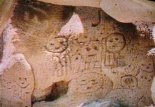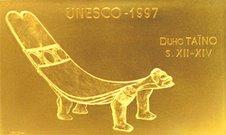 The first Amerindian lawyer of Guyana David James (left), along with his associate, Martin Cheong, programme assistant, legal services unit, APA recently took a tour of Dominica, St Vincent and Barbados. by Tracy Moore GUYANA'S FIRST Amerindian lawyer, David James, is making his mark in his homeland and the Caribbean.
The first Amerindian lawyer of Guyana David James (left), along with his associate, Martin Cheong, programme assistant, legal services unit, APA recently took a tour of Dominica, St Vincent and Barbados. by Tracy Moore GUYANA'S FIRST Amerindian lawyer, David James, is making his mark in his homeland and the Caribbean.
He recently became the legal advisor to the Amerindian Peoples Association of Guyana (APA), a non-governmental organisation, with objectives to promote the social, economic, political and cultural improvement of the Indigenous communities and to promote and defend their civil rights.
In other words, he has his work cut out for him.
James, along with his associate, Martin Cheong, programme assistant, Legal Services Unit, APA recently took a tour to Dominica, St. Vincent and Barbados lecturing about the plight of the Amerindians in Guyana.
"One of the purposes is to create awareness and we are also looking for solidarity from other indigenous people and non-indigenous people. I think there is still a thinking that indigenous people either not exists or that there are so few in numbers that nobody pays much attention to them.
"In Guyana, we number some ten per cent of the population which approximates to about 70 000," said the attorney-at-law.
He said that there were two main areas that the indigenous people and their organisation were concerned about.
"One has to be with the protection of our rights to lands, territories and resources which we have traditionally owned, occupied and used going back all the way to our ancestors.
"We are concerned that the present law – the new law – does not adequately equip us. For indigenous people, the land is the source for everything for us. It is the source for which our culture flows, our way of life depends on that and if we do not have legal security to that land in the form of title, then it means that we will face an uncertain future.
"At the moment, the law does not state that right and therefore it does not protect that right as far as I am concerned.
"All it does is say that power is in the hands of the relevant minister to determine whether indigenous communities are able to obtain title to their land or not, or extensions to titles," he explained.
Cheong added that the issues were deep-rooted from the days of Guyana's independence in 1966, when one of the conditions of independence were to resolve land rights issues pertaining to the Amerindian peoples.
"The next year, the government commissioned an Amerindian Lands Commission which went out to over 100 communities to listen to the concerns of the people. In 1969, a report was published," he cited.
He said the commission recommended that "some 24 000 square miles of Guyana should be titled as indigenous title land, but that the government did nothing until 1976."
"Seventy communities obtained titles, but that only amounted to 4 500 (square miles). During their visit of the commission, the indigenous leaders themselves and communities had said that some 43 000 square miles was their land – just a little over half of the country."The commission disagreed and said 24 000. Finally, what did we get? 4 500," he recalled.
"The struggle is with the law" said James, who added that it was based on a "philosophy of paternalism".
He explained that the law was steeped in "colonial ideology" which assumed "indigenous people basically couldn't think for themselves and therefore had to rely on the state to protect their interest".
"So under the law, we were seen as wards of the state. Basically, like children, and therefore the state had a lot of power over us in determining what was best for us," he said.
James and Cheong both acknowledged there had been a few improvements to the law recently, but not enough to meet their full approval.
"So although we have a new law now, we are not happy with some of the provisions. In 1991, the government issued a few more titles and then in 2004 at least two other titles were granted. Today, it stands at about 10 000 square miles" said Cheong.
With a total land mass of 83 000 square miles, a diverse population of three-quarters-of-a-million people – which the single largest population in the hinterlands are indigenous people – James and Cheong recognise that they have a battle ahead of them, but insist they will continue their struggle for their people.
 Santo Domingo.- 60 university students from Spain will arrive today Friday in the Dominican Republic to participate in the 3rd Tahina-Can Bancaja Expedition, for an 18 day tour of this Caribbean country, itinerary that includes adventure, cooperation and journalism.
Santo Domingo.- 60 university students from Spain will arrive today Friday in the Dominican Republic to participate in the 3rd Tahina-Can Bancaja Expedition, for an 18 day tour of this Caribbean country, itinerary that includes adventure, cooperation and journalism.









